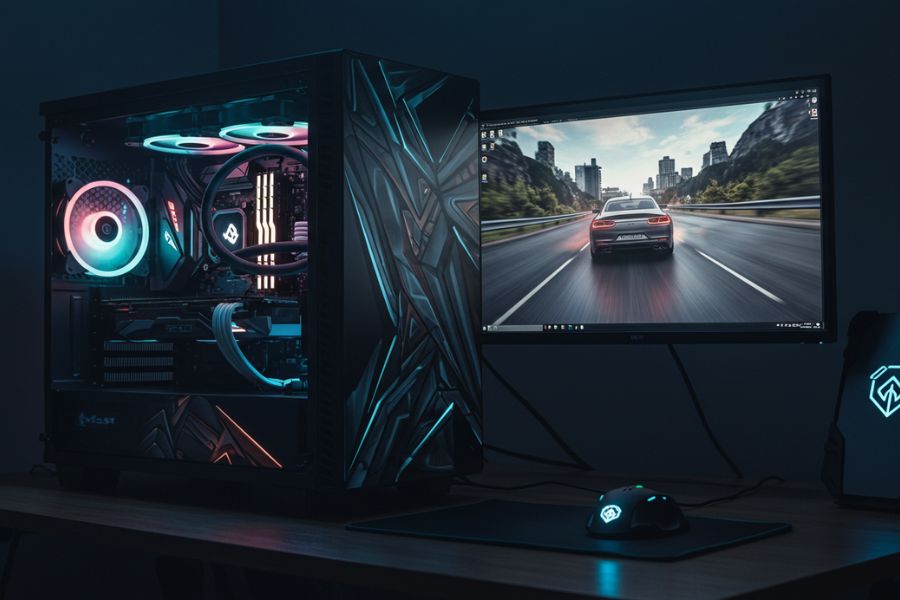Ray tracing represents a fundamental change for real-time graphics, calling forth great realism as it simulates how light interacts with virtual environments. Shadows would gain depth, reflections would become accurate, and lights would transform the feel of the scene into a cinematic one.
To achieve this visual accuracy, however, requires tremendous computational power. A smooth, high-frame-rate gaming experience with ray tracing requires some painstaking optimization.
Foundation: Hardware Recommendations
Optimization starts where the hardware ends. Ray tracing is demanding, to say the least, on the graphics processing unit. So invest in a powerful, dedicated GPU; NVIDIA’s GeForce RTX 2000, 3000, or 4000 series should form your main list of considerations; the same goes for any AMD Radeon RX series 6000 or 7000 variants.
These are hardware-accelerated ray-tracing capable, with RT Cores on NVIDIA vs. Ray Accelerators on AMD, meant to aid in efficiently dealing with all the computations involved. More GPU power than is required for ray tracing provides excessive headroom for using higher resolutions and settings at RTX 4070 Ti and above and RX 7900 XT and above.
Do not ignore the processor. Though the bulk of ray tracing is loaded on the GPU, the CPU controls the overhead of game logic, physics, and draw calls. A strong modern CPU (Intel Core i5/i7/i9 12th Gen and newer, AMD Ryzen 5/7/9 in 5000 series and newer) prevents bottlenecking, especially at lower resolutions.
Software and Driver Optimization
Your operating system and drivers form the critical software layer. Keep Windows or your preferred OS fully updated. Crucially, always install the latest graphics drivers directly from NVIDIA or AMD. Driver updates frequently include performance optimizations specifically for new games and ray tracing implementations.
Neglecting this step often leaves significant performance gains untapped. Within the operating system, prioritize performance. Set your power plan to High Performance in your Windows operating system.
Stop any undue background applications and services during gameplay that consume CPU cycles, memory, or bandwidth.
Game Settings: The Core To Improve Ray Tracing Performance
Game settings offer the most direct control over ray tracing GPU settings and overall performance. Navigate to the game’s graphics menu.
- Resolution: This is the single biggest performance factor. Higher resolutions (1440p, 4K) dramatically increase pixel count and GPU load. If struggling, lowering the resolution is the most effective way to gain frames.
- Ray Tracing GPU Settings: Modern games often provide granular control over ray-traced effects.
- Ray Tracing Preset: Start with a preset (Low, Medium, High, or Ultra) and adjust individual settings from there.
- Ray-Traced Reflections: Highly impactful but costly. Consider reducing the reflection quality or range.
- Ray-Traced Shadows: Can sometimes be replaced with high-quality traditional shadow maps without massive visual loss in many scenes.
- Ray-Traced Global Illumination (RTGI): Simulates complex light bouncing, hugely impactful but extremely demanding.
- Ray-Traced Ambient Occlusion (RTAO): Enhances contact shadows. It can sometimes be effectively replaced by traditional SSAO or HBAO+ solutions at a lower cost.
- Traditional Settings: Don’t ignore conventional settings, which also impact ray tracing performance:
- Shadows: High or ultra settings often pair well with RT shadows or can replace them if RT shadows are off. Medium might suffice.
- Textures: High/ultra textures use VRAM but typically have minimal GPU core impact. Ensure you have sufficient VRAM.
- Lighting/Effects: Settings like volumetric fog, bloom, and depth of field can be demanding. Adjust based on preference.
- Anti-Aliasing (AA): TAA is common. Avoid supersampling (SSAA) as it’s extremely heavy.
DLSS Settings for Gaming and Alternatives
Upscaling technologies are indispensable for improving ray tracing performance. They render the game at a lower internal resolution and intelligently upscale it to your display resolution, significantly boosting frame rates.
NVIDIA DLSS (Deep Learning Super Sampling):
Utilizes AI and Tensor cores for the highest quality reconstruction, especially DLSS 3 with Frame Generation on RTX 40 series GPUs. Within DLSS settings for gaming:
- Mode: Quality (best image, moderate boost), Balanced (good balance), Performance (higher boost, softer image), Ultra Performance (max boost, softest image, best for 8K). Prioritize quality or balance.
- Frame Generation (DLSS 3): If available on RTX 40 series, this inserts AI-generated frames, dramatically increasing FPS. Enable for maximum fluidity, but be aware it increases latency slightly (use Reflex).
AMD FidelityFX Super Resolution (FSR):
Open-source, works across NVIDIA and AMD GPUs. FSR 2/3 offers good quality.
- Mode: Similar Quality/Balanced/Performance/Ultra Performance presets.
- Frame Generation (FSR 3): AMD’s frame gen counterpart, also open-source and cross-vendor.
- Intel XeSS: Uses AI on Intel Arc GPUs, falling back to non-AI on others. Quality modes similar to DLSS/FSR.
Conclusion:
Successfully implementing how to optimize a gaming PC for ray tracing is an iterative process of balancing visual splendor with smooth performance. Start with a robust hardware foundation, then meticulously adjust in-game settings, prioritizing resolution and ray tracing quality levels.
Embrace DLSS, FSR, or XeSS as essential tools, selecting the mode that best fits your performance target and visual standards. Keep drivers current and manage system thermals. By methodically applying these professional tips for optimizing ray tracing, you unlock the breathtaking potential of ray-traced lighting while maintaining a responsive and enjoyable gaming experience.
